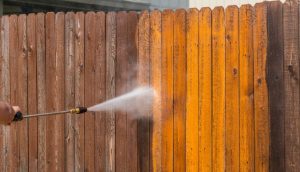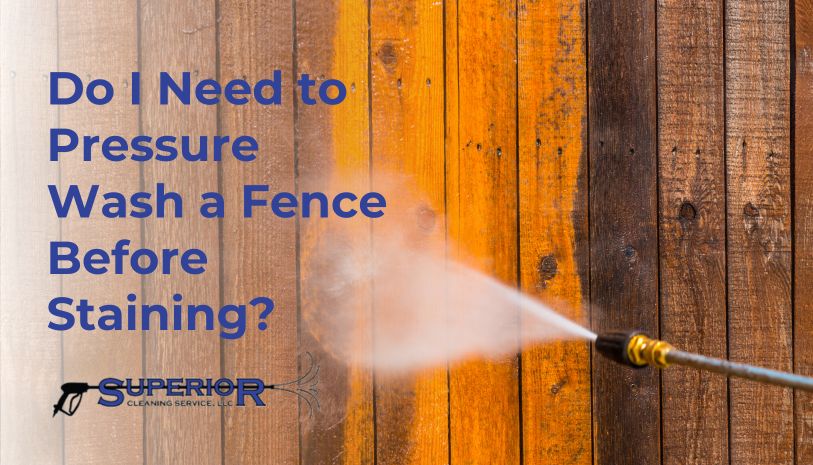Staining your fence is a significant step in maintaining its aesthetic appeal and durability, yet many homeowners wonder whether pressure washing beforehand is necessary. Prepping your fence with a pressure wash can remove dirt, grime, and old stains, promoting better adhesion and a longer-lasting finish. This guide will explore the benefits of pressure washing, offer expert tips, and discuss its importance in the staining process. Discover how this preparatory step can enhance the longevity and appearance of your fence, ensuring it remains a standout feature of your outdoor space.
Why Pressure Washing Your Fence Before Staining Is Essential
Cleaning your wooden fence before applying stain is essential for achieving the best results. A clean surface ensures the stain adheres properly, enhances its longevity, and provides a smooth, even finish. Pressure washing removes dirt, grime, and other residues that could affect the appearance and durability of the stain. Preparing your fence thoroughly before staining not only improves its look but also helps protect the wood for years to come.
| Reason | Description |
| Removes Dirt and Grime | Pressure washing effectively removes accumulated dirt, grime, and environmental particles from the surface, ensuring a clean base for the stain to adhere properly. |
| Eliminates Mold and Mildew | It helps eliminate mold, mildew, and algae, which can interfere with the staining process and affect the longevity and appearance of the finish. |
| Prepares Surface for Stain | A clean surface ensures that the stain penetrates the wood evenly, providing uniform color and protection. |
| Enhances Longevity of Stain | By removing impurities, pressure washing ensures that the stain adheres better, enhancing its durability and resistance to environmental wear. |
| Reveals the Condition of Wood | Pressure washing reveals damage or imperfections, allowing for repairs before applying stain, which can lead to a smoother and more attractive finish. |
| Improves Aesthetic Appeal | Cleaning the fence restores its natural beauty, allowing the true color and grain of the wood to be enhanced with a stain. |
| Prevents Future Damage | Removing damaging elements like mold and algae prevents wood decay and extends the life of both the stain and the fence itself. |
Steps to Prepare Your Fence for Staining
- Ensure the surface is free of dirt and impurities
- Use pressure washing as an efficient cleaning method
- Confirm the wood is dry before applying the stain
- Inspect for any remaining debris or damage
- Ensure the wood is ready to absorb the stain evenly

Understanding the Importance of a Clean Surface
Before you can effectively stain your wooden fence, it’s vital to begin with a surface that’s free of dirt and impurities. Pressure washing serves as an efficient method for cleaning your fence, ensuring the wood is ready to absorb the stain evenly. Without a clean surface, wood stains might not adhere properly, leading to blotchy finishes or premature fading. Additionally, a dirty fence can harbor mold, which not only affects the appearance but also the durability of the wood. By using a pressure washer, you remove dirt, grime, and old finishes, helping the new stain penetrate deeper into the wood. This deep cleaning process is critical in prolonging the life of your fence, making pressure washing an essential preparatory step in any staining project.
Steps to Properly Pressure Wash a Fence
- Choose the right power washer with adjustable pressure settings.
- Wear appropriate safety gear, including goggles and gloves.
- Clear the area around the fence of any debris or obstacles.
- Test a small, inconspicuous area of the fence to ensure the pressure won’t cause damage.
- Begin washing from the top of the fence and work your way down.
- Maintain a consistent distance from the fence to avoid uneven cleaning.
- Use a sweeping motion to cover the entire surface evenly.
- Rinse with clean water to remove any detergent residue.
- Allow the fence to dry completely before applying any treatments or sealants.
- Inspect the fence for any needed repairs after cleaning.
Using a Power Washer for Effective Results
Using a power washer to clean your fence can yield highly effective results when done correctly. Start by choosing a power washer with an adjustable psi setting, ideally between 1500 to 2000 psi. This range is optimal for removing grime without damaging the wood. First, apply a detergent specifically formulated for wooden surfaces, as this aids in loosening tough dirt and old stains. Ensure that the nozzle is set to a wide spray to evenly distribute water across the fence, minimizing the risk of gouging. Move the spray steadily along the length of the fence, maintaining an even distance from the surface. This approach ensures a thorough wash, preparing the fence for a smoother and more even stain application. Proper power washing is crucial to removing impurities that can impede the staining process, leading to enhanced longevity and aesthetic of your fence.
Preparing Your Fence Before Staining
Preparing your fence properly is key to achieving a long-lasting, even stain. Cleaning the surface thoroughly and choosing the right time to stain are essential steps. By following these preparation tips, you can enhance your fence’s appearance and durability. Let’s dive into the best practices for getting your fence ready for staining.
Tips to Ensure Your Fence Is Ready
Before staining, it’s crucial to ensure your fence is adequately prepared to accept the stain. Start by examining the fence posts and the entire structure for any signs of damage or wear. Repair any loose or broken sections as these can affect the final outcome. Gates and fence panels should be aligned and in good condition before staining. Next, give special attention to cleaning. Though pressure washing is effective, some wooden fences may benefit from additional treatments such as a bleach solution to remove mildew. Ensure the surface is thoroughly dry before applying stain, typically waiting 24 to 48 hours post-wash is advisable. This time allows any water to evaporate, minimizing the risk of trapping moisture under the stain, which could lead to blistering or peeling.
Advantages of Using a Pressure Washer for Fence Cleaning
 Pressure washing is an effective and efficient way to clean your fence, helping to remove built-up dirt, grime, mold, and mildew that can accumulate over time. By using a high-powered stream of water, it not only restores the fence’s appearance but also prepares the surface for staining or painting, ensuring better adhesion and a longer-lasting finish. Unlike traditional cleaning methods, such as scrubbing by hand, pressure washing delivers faster, more thorough results with less effort, making it a popular choice for both DIY enthusiasts and professional contractors. It’s also an eco-friendly option when used without harsh chemicals, relying on the force of water to do the job. Whether you’re revitalizing an old fence or prepping a new one, pressure washing is a reliable solution to get it ready for the next steps.
Pressure washing is an effective and efficient way to clean your fence, helping to remove built-up dirt, grime, mold, and mildew that can accumulate over time. By using a high-powered stream of water, it not only restores the fence’s appearance but also prepares the surface for staining or painting, ensuring better adhesion and a longer-lasting finish. Unlike traditional cleaning methods, such as scrubbing by hand, pressure washing delivers faster, more thorough results with less effort, making it a popular choice for both DIY enthusiasts and professional contractors. It’s also an eco-friendly option when used without harsh chemicals, relying on the force of water to do the job. Whether you’re revitalizing an old fence or prepping a new one, pressure washing is a reliable solution to get it ready for the next steps.
Why Power Wash Over Other Methods
The choice to use a power washer over other cleaning methods hinges primarily on its efficiency and effectiveness. Traditional methods like scrubbing require significant physical effort and may not remove all the embedded dirt and grime from the fence surface. A pressure washer, on the other hand, uses high-pressure water jets to power through dirt, mildew, and old stains rapidly, achieving results that are both clear and thorough. This not only saves time but ensures a more uniform surface for staining. Furthermore, pressure washing can reach the intricate spots around fence posts and other tricky areas, which might otherwise be neglected. Compared to other methods, it provides a comprehensive clean that better prepares the fence for paint or stain application. Additionally, when used correctly, it reduces the likelihood of damaging wood or vinyl materials, offering peace of mind for projects ranging from wooden fences to outdoor furniture maintenance. With a power washer, you can expect excellent outcomes that enhance the longevity and appearance of your fence.
Common Mistakes When Staining a Fence
Staining a wooden fence requires attention to detail to ensure a durable and high-quality finish that enhances the fence’s appearance and protects it from the elements. Start by preparing the surface, which involves removing dirt, debris, and old paint or stain using a power washer or gentle sanding. Once clean, allow the fence to dry thoroughly before applying the stain. Choosing a high-quality stain suited to your fence material is crucial, as it helps resist weathering, UV damage, and moisture. Regular maintenance, such as reapplying the stain every few years and inspecting for wear, will keep your fence looking fresh and lasting for years to come.
Avoiding Fence Stain Issues for Lasting Impact
A crucial mistake in staining a fence is neglecting proper surface preparation. Ensuring that the fence is free from dirt and old stain is critical for achieving a uniform application. Pressure washing is an effective method to prepare the surface, removing accumulated grime that compromises the new stain’s adhesion. It’s equally important to repair any damage, aligning the fence and gates to prevent uneven wear. Another common pitfall is applying the stain in adverse conditions. Humidity and rain can interfere with the stain’s ability to dry evenly, leading to a blotchy finish. Always check weather forecasts to ensure optimal conditions. Moreover, using the wrong type of stain or paint can lead to premature wear. Opt for stains specifically designed for wooden surfaces such as fences and decks, as these are formulated to withstand outdoor elements better. Lastly, applying too heavy a coat of stain can lead to drips and uneven patches. By employing these strategies, you can significantly extend the longevity of your stained fence’s appearance and functionality.

Pressure washing your fence before staining is essential for achieving a uniform, long-lasting finish. It removes dirt, mold, and old stains while preparing the wood to absorb the new stain more effectively, improving its durability. Though it may feel like an added step, pressure washing can save time and effort by preventing premature wear and reducing the need for frequent re-staining. Proper preparation ensures the stain provides maximum aesthetic and protective benefits, leaving you with a beautiful, enduring fence.
FAQs
Q: Why is pressure washing essential before staining a fence?
A: Pressure washing is crucial before staining a fence because it effectively removes dirt, grime, old stains, and any other impurities that may hinder the stain’s adhesion to the wood. This process ensures a clean surface, allowing the stain to penetrate evenly and enhancing the overall durability and appearance of the fence.
Q: What are the benefits of using a pressure washer for cleaning a fence before staining?
A: Utilizing a pressure washer offers several benefits, including efficient removal of embedded dirt and old stains, reaching intricate spots around fence posts, and ensuring a uniform surface for stain application. A pressure washer provides a comprehensive clean that is often more effective than traditional manual cleaning methods, thereby improving the longevity and aesthetic appeal of the stained fence.
Q: What steps should be taken before using a pressure washer on a fence?
A: Before using a pressure washer, inspect the fence for damage, such as loose or broken sections, and make necessary repairs. Choose a power washer with an adjustable psi setting within the 1500-2000 psi range to avoid damaging the wood. Apply a detergent suitable for wooden surfaces to aid in loosening stubborn dirt and stains, and ensure the spray nozzle is set to provide an even distribution of water across the fence.
Q: How should proper drying times and weather conditions be considered before staining a fence?
A: After pressure washing, it is essential to allow the fence to dry thoroughly for at least 24 to 48 hours to prevent moisture from being trapped under the stain, which can lead to blistering or peeling. Choose a dry, non-humid day for staining to ensure the best results and avoid applying stain in adverse weather conditions, such as during rain or high humidity.
Q: What common mistakes should be avoided when staining a fence after pressure washing?
A: Common mistakes include neglecting proper surface preparation, applying the stain in unsuitable weather conditions, using the wrong type of stain, and applying too heavy a coat. It’s crucial to ensure the fence is clean and dry before beginning, select a stain designed for outdoor wooden surfaces, and apply a light, even coat to prevent drips and uneven patches, thereby maximizing the stain’s longevity and effectiveness.


